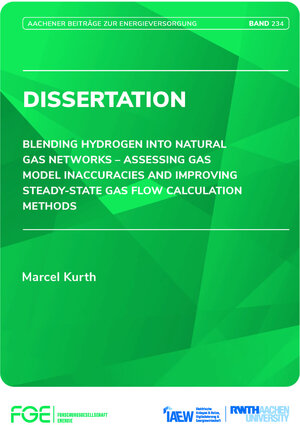
×
![Buchcover ISBN 9783982635422]()
BLENDING HYDROGEN INTO NATURAL GAS NETWORKS – ASSESSING GAS MODEL INACCURACIES AND IMPROVING STEADY-STATE GAS FLOW CALCULATION METHODS
von Marcel Kurth, herausgegeben von Albert Univ.-Prof. Dr.-Ing. MoserThe transition to decarbonization of energy-intensive sectors such as chemicalsand steel depends on the availability of hydrogen from renewable sources. Furthermore, the potential of green hydrogen to reduce carbon emissions in numerous other sectors, including the heating sector, is currently under discussion. In this context, the use of the existing gas network infrastructure
for the transmission and distribution of hydrogen plays an important role in the necessary market ramp-up.
Hydrogen exhibits distinctive physical properties in comparison to natural gas. These include a lower calorifi c value, lower density, higher compressibility factor, and a negative Joule-Thomson coeffi cient. Recent studies demonstrate that these distinct properties result in higher pressure losses in pipelines, the need for increased compressor power in the transmission network, and potential savings in preheating at gas pressure regulating stations. In these studies, investigations are often conducted for blends encompassing a range of hydrogen concentrations from 0% to 100% hydrogen, with the objective of illustrating the impact of altered operational requirements in the context of the modifi ed physical properties of the gas.
Since these studies use different equations of state to approximate thethermodynamic properties of natural gas-hydrogen mixtures, this thesis examines the inaccuracies of various equations of state used in the literature compared to the reference AGA8-92DC equation of state, and how these model errors propagate in the simulation of pipelines, compressor stations, gas pressure regulating stations with control valves, and gas pressure regulating stations with expansion turbines. The results indicate that the Redlich-Kwong-Soave and Redlich-Kwong equations of state are viable alternatives to the AGA8-92DC model, whereas the Peng-Robinson and van der Waals equations of state result in unacceptable deviations.
In addition to model accuracy, robustness and runtime effi ciency are important considerations. The Newton-Raphson method is frequently employed for steady-state gas fl ow calculations due to its high runtime effi ciency. However, it has the disadvantage of limited robustness. The investigations of the second part of the thesis demonstrate how the Newton-Raphson method can
be combined with other methods to enhance robustness.
for the transmission and distribution of hydrogen plays an important role in the necessary market ramp-up.
Hydrogen exhibits distinctive physical properties in comparison to natural gas. These include a lower calorifi c value, lower density, higher compressibility factor, and a negative Joule-Thomson coeffi cient. Recent studies demonstrate that these distinct properties result in higher pressure losses in pipelines, the need for increased compressor power in the transmission network, and potential savings in preheating at gas pressure regulating stations. In these studies, investigations are often conducted for blends encompassing a range of hydrogen concentrations from 0% to 100% hydrogen, with the objective of illustrating the impact of altered operational requirements in the context of the modifi ed physical properties of the gas.
Since these studies use different equations of state to approximate thethermodynamic properties of natural gas-hydrogen mixtures, this thesis examines the inaccuracies of various equations of state used in the literature compared to the reference AGA8-92DC equation of state, and how these model errors propagate in the simulation of pipelines, compressor stations, gas pressure regulating stations with control valves, and gas pressure regulating stations with expansion turbines. The results indicate that the Redlich-Kwong-Soave and Redlich-Kwong equations of state are viable alternatives to the AGA8-92DC model, whereas the Peng-Robinson and van der Waals equations of state result in unacceptable deviations.
In addition to model accuracy, robustness and runtime effi ciency are important considerations. The Newton-Raphson method is frequently employed for steady-state gas fl ow calculations due to its high runtime effi ciency. However, it has the disadvantage of limited robustness. The investigations of the second part of the thesis demonstrate how the Newton-Raphson method can
be combined with other methods to enhance robustness.


